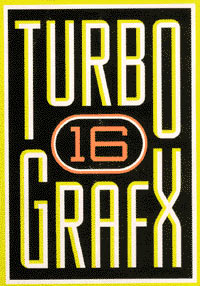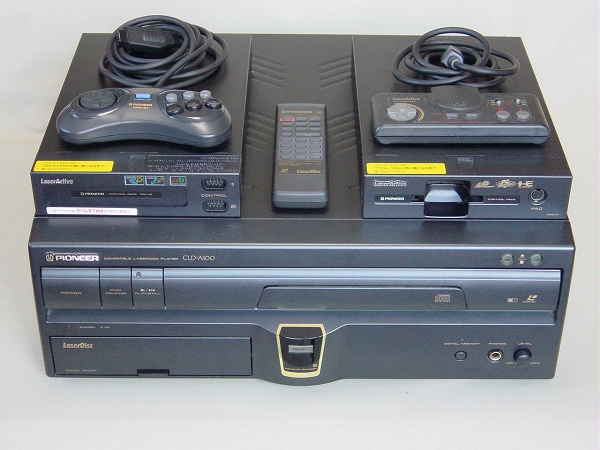|
TurboGrafx-16
The TurboGrafx-16, known in Japan as the , is a home video game console developed by Hudson Soft and manufactured by NEC. It was released in Japan in 1987 and in North America in 1989. The first console of the fourth generation of video game consoles, fourth generation, it launched in Japan to compete with Nintendo's Family Computer, Famicom, but its delayed U.S. debut placed it against the more advanced Sega Genesis and later the Super Nintendo Entertainment System, Super NES. The TurboGrafx-16 features an 8-bit computing, 8-bit CPU paired with dual 16-bit graphics processors, and supports up to 482 on-screen colors from a palette of 512. The "16" in the console’s North American branding was criticized as misleading. With dimensions of , the PC Engine remains the smallest major home console ever released. Games were initially released on HuCard cartridges, but the platform later supported additional formats requiring separate hardware: TurboGrafx-CD (''CD-ROM²'' in Japan) ga ... [...More Info...] [...Related Items...] OR: [Wikipedia] [Google] [Baidu] |
Fourth Generation Of Video Game Consoles
In the history of video games, the fourth generation of video game consoles, more commonly referred to as the 16-bit era, began on October 30, 1987, with the Japanese release of NEC Home Electronics' PC Engine (known as the TurboGrafx-16 in North America). Though NEC released the first console of this era, sales were mostly dominated by the rivalry between Sega and Nintendo across most markets: the Sega Genesis, Sega Mega Drive (known as the Sega Genesis in North America) and the Super Nintendo Entertainment System (known as the ''Super Famicom'' in Japan). Cartridge-based handheld game consoles became prominent during this time, such as the Game Boy, Nintendo Game Boy, Atari Lynx, Game Gear, Sega Game Gear and TurboExpress. Nintendo was able to capitalize on its success in the Third generation of video game consoles, third generation, and managed to win the largest worldwide market share in the fourth generation as well. However, particularly in the lucrative North American mark ... [...More Info...] [...Related Items...] OR: [Wikipedia] [Google] [Baidu] |
Bonk's Adventure
''Bonk's Adventure'', known as in Japan, ''PC Kid'' and ''B.C. Kid'' in Europe, is a scrolling platform game developed by Red Company and Atlus and released in 1989 in Japan and 1990 in North America for the PC Engine/TurboGrafx-16. The Japanese title ''PC Genjin'' is a play on the system's original name, PC Engine, with the European title ''PC Kid'' similarly referencing the system's name. The first game in the ''Bonk'' series, it was followed by two more games for the TurboGrafx-16 before branching out to other platforms. ''Bonk's Adventure'' was ported to the NES and Amiga, as well as being released as a coin-operated arcade game, under different titles (''FC Genjin'' and ''BC Genjin'' in Japan, and ''BC Kid'' in Europe). A completely different game with the same name appeared on the Game Boy (under the title ''GB Genjin'' in Japan). Plot The game takes place in a fictional prehistoric era. Its protagonist is Bonk, a strong and bald caveboy who battles anthropomorphic di ... [...More Info...] [...Related Items...] OR: [Wikipedia] [Google] [Baidu] |
LaserActive
The is a hybrid LaserDisc player and home video game console released by Pioneer Corporation in 1993. Marketed as a high-end, modular entertainment system, it was designed to combine movies, music, and video games into a single unit. Out of the box, the base unit could natively play standard LaserDisc, LaserDiscs and Compact discs, but support for video games required optional expansion modules known as PACs. Each PAC enabled compatibility with a specific gaming platform and its media formats. With the Mega-LD PAC, the system could play exclusive Mega-LD discs (a proprietary LD-ROM format), as well as Sega Genesis/Mega Drive cartridges and Sega CD/Mega CD, Sega CD/Mega-CD discs. With the LD-ROM² PAC, it supported exclusive LD-ROM² discs, along with HuCard cartridges and CD-ROM² discs for the PC Engine/TurboGrafx-16. The LaserActive was the only system capable of playing LD-ROM game discs, which were not cross-compatible between PACs. Pioneer released LaserActive model CLD-A10 ... [...More Info...] [...Related Items...] OR: [Wikipedia] [Google] [Baidu] |
Hudson Soft HuC6270
HuC6270 is a video display controller (VDC) developed by Hudson Soft and manufactured for Hudson Soft by Seiko Epson. This VDC was used in the PC Engine game console series produced by NEC Corporation, and the upgraded PC Engine SuperGrafx. Technical specification The HuC6270 generates a display signal composed a 9-bit stream pixel data with a color and palette indexes, and indication of whether the pixel corresponds to background (with x y scrolling) or sprites. This data can be used by a colour encoder to output graphics. It uses external VRAM via a 16-bit address bus. It can display up to 64 sprites on screen, with a maximum of 16 sprites per horizontal scan line. The minimum resolution is 256 × 224 pixels, with resolutions up to 512 × 240 being possible. Uses The HuC6270 was used in consoles of the PC Engine, SuperGrafx and TurboGrafx-16 ranges. Additionally, the VDC was used in arcade games: * '' Alien Crush'' * '' Blazing Lazers'' * '' Bloody Wolf'' * ''Fishin ... [...More Info...] [...Related Items...] OR: [Wikipedia] [Google] [Baidu] |
Hudson Soft
was a Japanese video game company known for releasing numerous titles across video game consoles, home computers, and mobile phones. Headquartered in the Midtown Tower in Tokyo, it also maintained an office in the Hudson Building in Sapporo. Founded on May 18, 1973, Hudson initially focused on personal computer products before expanding into video game development, publishing, peripherals, and music production. The company was best known for its series ''Bomberman'', '' Adventure Island'', '' Star Soldier'', '' Bonk'' and '' Bloody Roar''. It also developed games for other publishers, most notably the ''Mario Party'' series for Nintendo. Hudson partnered with NEC to create the TurboGrafx-16, TurboExpress, and PC-FX consoles, aiming to compete with Nintendo, Sega, and SNK, while continuing to release games on other platforms as a third-party developer. Hudson Soft became a publicly traded company in 2000. In 2005, Konami acquired a 55% controlling stake in Hudson, later p ... [...More Info...] [...Related Items...] OR: [Wikipedia] [Google] [Baidu] |
Sega Genesis
The Sega Genesis, known as the outside North America, is a 16-bit Fourth generation of video game consoles, fourth generation home video game console developed and sold by Sega. It was Sega's third console and the successor to the Master System. Sega released it in 1988 in Japan as the Mega Drive, and in 1989 in North America as the Genesis. In 1990, it was distributed as the Mega Drive by Virgin Mastertronic in Europe, Ozisoft in Australasia, and Tectoy in Brazil. In South Korea, it was distributed by Samsung Electronics as the Super Gam*Boy and later the Super Aladdin Boy. Designed by an Research and development, R&D team supervised by Hideki Sato and Masami Ishikawa, the Genesis was adapted from Sega's Sega System 16, System 16 arcade board, centered on a Motorola 68000 processor as the central processing unit, CPU, a Zilog Z80 as a sound controller, and a video system supporting hardware Sprite (computer graphics), sprites, Tile-based video game, tiles, and scrolling. It ... [...More Info...] [...Related Items...] OR: [Wikipedia] [Google] [Baidu] |
HuCard
The (Known as the TurboChip in regions where the PC Engine was marketed as the TurboGrafx-16) is a ROM cartridge in the form of a card, designed by Hudson Soft for NEC's PC Engine and PC Engine SuperGrafx video game consoles, which were originally released in 1987 and 1989, respectively. Development The HuCard is an evolution from an earlier Hudson Soft technology, the Bee Card, which it developed in the early 1980s as a distribution medium for MSX software. The Bee Card is an EEPROM device that is slightly thinner than the HuCard. It has 32 connectors whereas the HuCard has 38. In July 1985, Hudson approached and pitched Nintendo a new add-on for the Famicom that played games using the patented Bee Cards. Nintendo liked this concept, as it had the ability to store full games and overwrite existing ones. However, as the technology for it was expensive, and that they would have to pay royalties for each card sold, Nintendo decided to pass on Hudson's proposal and woul ... [...More Info...] [...Related Items...] OR: [Wikipedia] [Google] [Baidu] |
HuC6280
The HuC6280 8-bit microprocessor is Japanese company Hudson Soft's improved version of the WDC 65C02 CPU, an upgraded CMOS version of the popular NMOS-based MOS Technology 6502 8-bit CPU, manufactured for Hudson by Seiko Epson and NEC. The most notable product using the HuC6280 is NEC's TurboGrafx-16 video game console. Description The HuC6280 contains a 65C02 core which has several additional instructions and a few internal peripheral functions such as an interrupt controller, a memory management unit, a timer, an 8-bit parallel I/O port, and a programmable sound generator (PSG). The processor operates at two speeds, 1.79 MHz and 7.16 MHz. A slightly revised HuC6280A was released and used in the PC Engine CoreGrafx and SuperGrafx. This revision reportedly fixed some minor audio issues in those systems. Memory mapping Source:https://github.com/MiSTer-devel/TurboGrafx16_MiSTer/blob/master/docs/HuC6280%20-%20CMOS%208-bit%20Microprocessor%20Hardware%20Manual.pdf The Hu ... [...More Info...] [...Related Items...] OR: [Wikipedia] [Google] [Baidu] |
PC Engine SuperGrafx
The , also known as simply the SuperGrafx, is a Fourth generation of video game consoles, fourth-generation home video game console manufactured by NEC Home Electronics and released in Japan in 1989. It is the successor system to the TurboGrafx-16, PC Engine, released two years prior. Originally known as the PC Engine 2 during production stages, it was purported as a true 16-bit home console, featuring improved graphics and audio capabilities over its predecessor. The console was rushed to market, released several months before its initial intended release date in 1990, only having modest updates to the hardware. With only six retail games released that took advantage of the console's hardware updates, the SuperGrafx was a commercial failure, selling only 75,000 units total. None of the hardware advancements it possessed were carried over to later PC Engine models, such as the TurboDuo, Duo & the LD-ROM² PAC for the LaserActive. Hardware Compared to the PC Engine, the SuperGra ... [...More Info...] [...Related Items...] OR: [Wikipedia] [Google] [Baidu] |
PC-FX
The is a 32-bit home video game console co-developed by NEC and Hudson Soft. Released in December 1994, it is based on the NEC V810 CPU and CD-ROM, and was intended as the successor to the PC Engine (known overseas as the TurboGrafx-16). Unlike its predecessor, the PC-FX was only released in Japan. Its form factor is like that of a tower PC, intended to be similarly upgradeable. The PC-FX was uncompelling in the marketplace due to lack of a 3D polygon-based graphics chip, high price, and limited developer support and is considered a commercial failure. It was discontinued in February 1998 and NEC subsequently exited the home video game console business. History In 1987, NEC partnered with game publisher Hudson Soft to create the PC Engine, released internationally as the TurboGrafx-16. The PC Engine was successful in Japan, but the TG-16 struggled in overseas markets. The success of the PC Engine created a strong relationship between NEC and Hudson, who began work on a tru ... [...More Info...] [...Related Items...] OR: [Wikipedia] [Google] [Baidu] |







